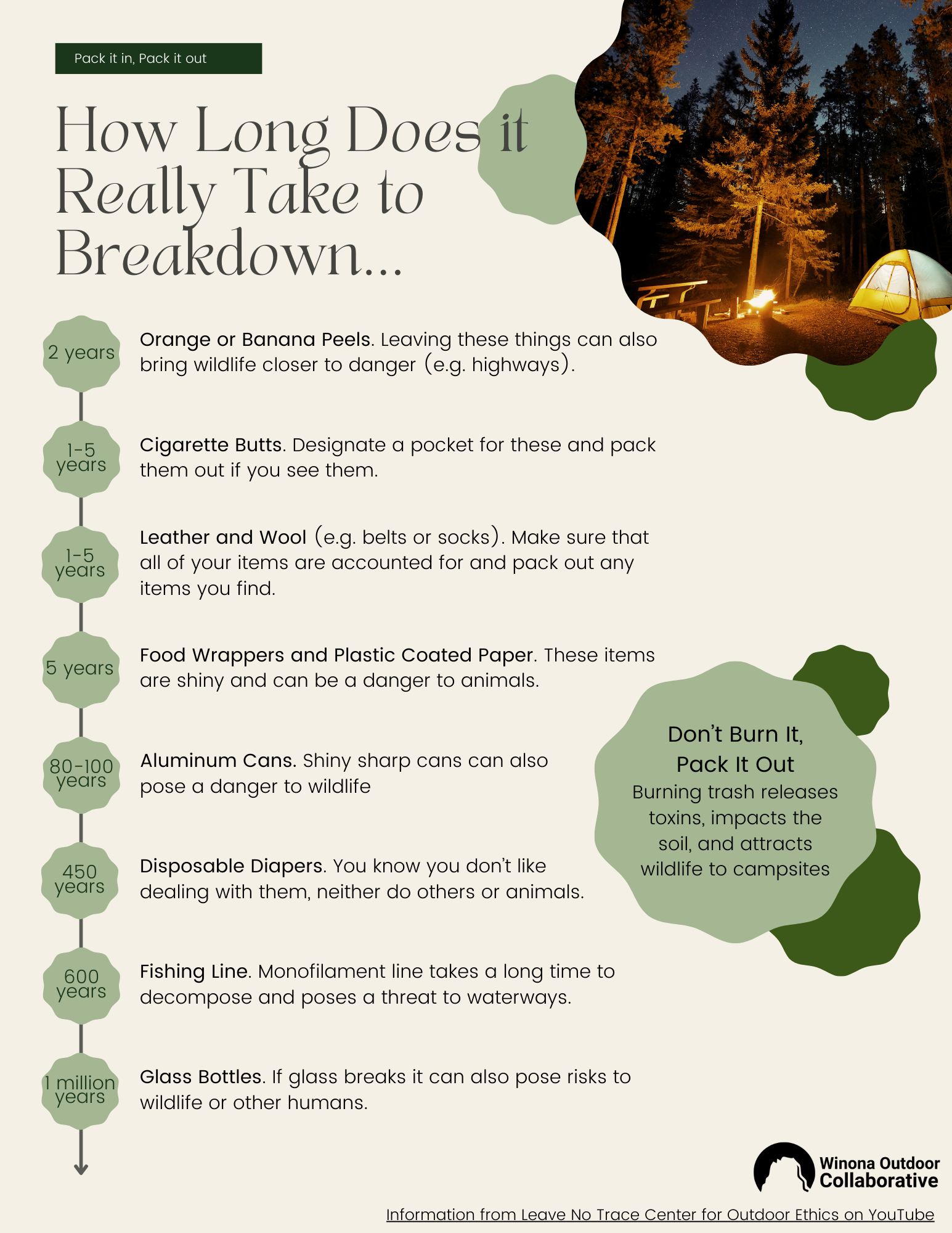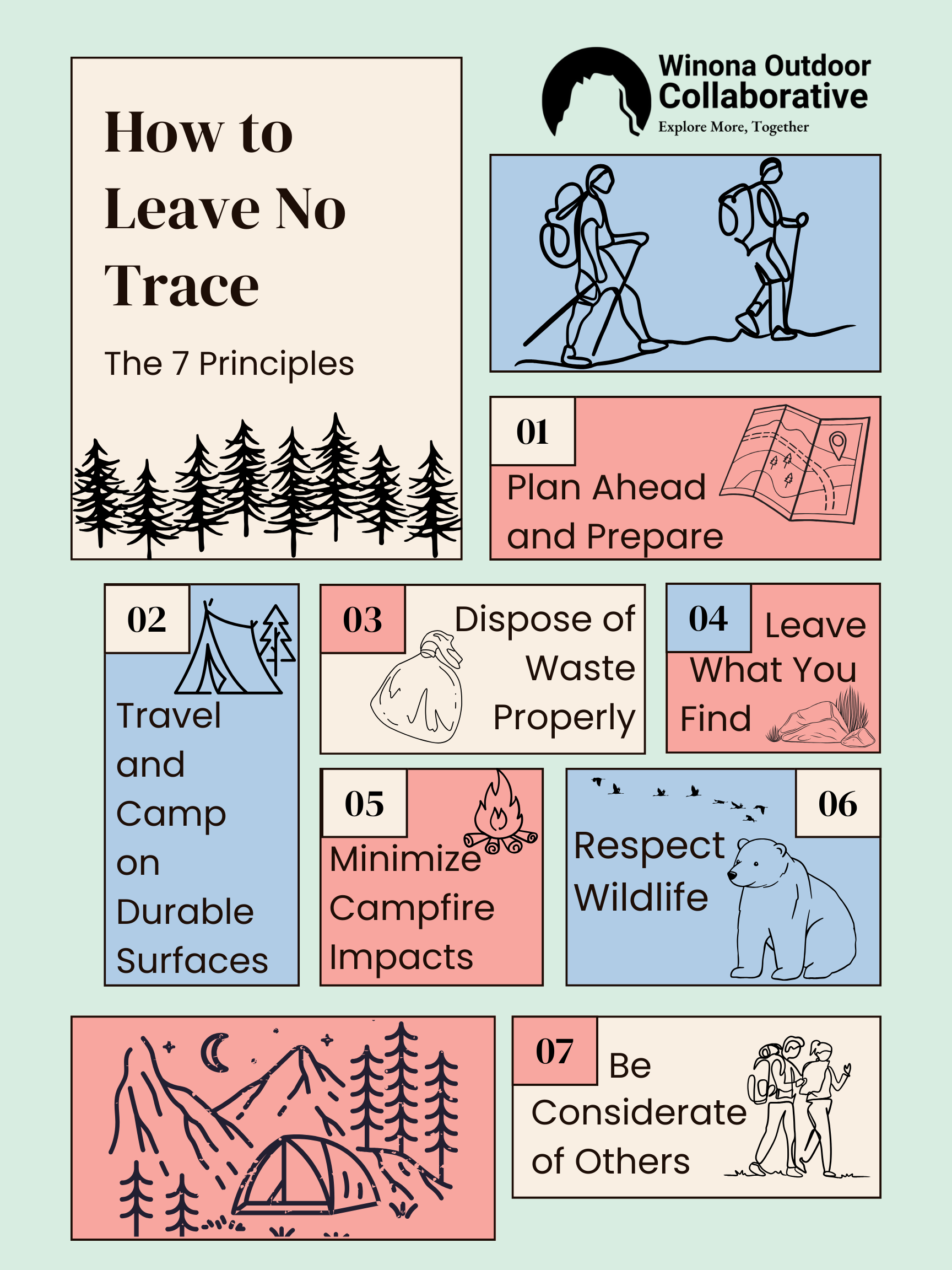The Art of Leave No Trace
Photograph Provided by Shannon Spies
It can be exciting as the days have been getting longer to look ahead at all the summer recreation activities we enjoy. But, it is also important to learn how we can best minimize our impact on the environment while still enjoying the activities we love.
In this Post…
The 7 Principles of Leave No Trace
What is Leave No Trace?
The Leave No Trace Center for Outdoor Ethics is a national organization dedicated to using education and science to protect all of the natural world, from the deepest wilderness areas to local parks.
Through education, outreach, and action, Leave No Trace works to prevent some of the major issues our natural world faces today.
This includes…
Trash in natural areas
Polluted waters
At-risk wildlife
Damaged trail systems
Destructive wildfires
To achieve these goals, Leave No Trace has provided a set of 7 guidelines to provide a simple framework to ensure we are always respectful when exploring and doing our best to minimize our impact on the natural world.
The 7 Principles of Leave No Trace
1. Plan Ahead and Prepare
While spontaneity has a natural draw, it may be best to leave that at home when heading out for a trip. Planning a trip in advance is best practice and it can help lead to a more enjoyable experience, both for you and for those around you.
Even if you are only going out for the day, there are important things to keep in mind to plan ahead for. Consider checking the weather conditions, regulations or special conditions of the area, the terrain and required skill level.
A good rule of thumb is to always pack the “10 Essentials”. This is a list of items that can be essential to survival if a dangerous situation arises.
The “10 Essentials” are…
Navigation Systems
Headlamp
Sun Protection
First Aid
A Knife
Fire Starting Materials
Shelter
Extra Food
Extra Water
Extra Clothes
Read more about this updated list of the “10 Essentials” for packing from REI here.
2. Travel and Camp on Durable Surfaces
Travel damage occurs when vegetation or ecosystems are trampled beyond recovery. This harms the natural landscape and wildlife in many ways. The most basic way to avoid this is to stay on established trails and only camp in established campsites.
When Hiking…
When hiking, stay on the trail. Trail systems are created to concentrate foot traffic, and although they do have an impact on the land, they help to minimize and control that impact. Even if the path is muddy, stick to the center of the trail. When we try to skirt the mud while hiking it can widen the trail and damage the surrounding landscape.
If you are hiking through undisturbed off-trail areas (to use the bathroom or for exploration around a campsite), it is important to consider surface durability (the ability of the land and vegetation to recover) and frequency (the amount of people and number of times that an area will be traveled).
When Camping…
When camping in developed campsites or campgrounds, it is best to select sites that fit the size of your group. This helps to prevent what is called site creep, which occurs when the boundaries of a site are continuously and incrementally worn down and expanded over time.
Now, camping in undeveloped areas takes much more consideration. This decision relies on information about the area’s soil and wildlife, previous impacts, and potential impacts you may cause. The Leave No Trace principles suggest that “Good campsites are found, not made,” meaning that you shouldn’t have to modify an area to make it good for camping, you should find an area that is already suitable.
3. Dispose of Waste Properly
Info from Leave No Trace on YouTube
This may be a little bit of a ‘crappy’ topic, but is one of the most important. Waste can take on different forms, including trash, wastewater, and human waste.
When dealing with trash, the best practice to follow is “pack it in, pack it out.” As most of the trash we generate will take a very long time to break down, it is best not to leave it in areas where other adventurers or wildlife can stumble upon it. This includes things like organic waste and tiny pieces of trash that may easily be overlooked when packing up.
It is recommended that any wastewater is disposed of at least 200 feet away from other water sources to avoid contamination. Things like soaps or lotions can easily affect the water quality of nearby water sources, but dumping them far away from those sources allows for the soil to act as a filter before the water makes its way back into the natural flow.
Human waste can be the most dangerous to dispose of because it can also pose a direct risk to other people, not just animals. On shorter hikes where restrooms are available, use the provided facilities before setting out. But in the backcountry, where you may not have access to a restroom or latrine, you may just need to build your own. Just as for wastewater, it is recommended to travel 200 feet from water sources, established trails, or campsites and dig a hole about 6-8 inches deep. (You can also check out another blog post from the Collaborative here for more info on how to ‘go’ outside or this video from REI which breaks down the LNT guidelines on this topic further)
4. Leave What You Find
Everything in nature has a role to play. From rocks and sticks to ferns and flowers every element of the natural ecosystem is essential. That is why it is so important to leave all natural objects in place. Some of the most tempting objects, like antlers, patterned rocks, or brightly colored flowers, can also give others a sense of discovery while exploring the outdoors.
It is also important to be conscious of the live trees and plants while exploring. Actions like staying on an established trail can help to save small flora and fauna that may fall underfoot. When hanging hammocks or clotheslines, remember to use thick straps to avoid a strain on the tree, and select one with a large trunk, usually at least 12 inches in diameter.
5. Minimize Campfire Impacts
Although campfires are often strongly associated with camping, they can also be extremely dangerous. Here are some tips and tricks to help minimize the potential risks of a fire.
Only use existing fire rings. This may sound simple, but it can have a large impact on the natural environment. Additionally, keeping the fire small and never leaving it unattended can help make sure to prevent it from getting out of hand.
Putting out the fire could be considered the most important step. Make sure to burn the wood until it turns to ash, then soak the fire in water until the ashes are cool to the touch. If you aren’t sure, put some more water on it.
When packing up to head out, don’t forget to pick out any litter from the fireplace. In the backcountry you may also need to scatter fire remains away from camp and some places may require you to pack out ashes.
Even though there are ways to help manage potential risks, there are also alternatives to campfires altogether. Instead of using a campfire for cooking food you could use a camp stove or pack no-cook meals. If you plan to use a campfire for light, opt for a lantern or flashlight instead. And if you were looking forward to that campfire just for the fun of it, consider stargazing or a night hike as a way to explore the wider world around us.
6. Respect Wildlife
Seeing an animal while camping or out on the trail can be downright cool, but it might not be so cool for the animals themselves. When we see an animal, it is important to remember to keep our distance. This can also include keeping pets at a safe distance and under our control as they adventure along with us. Keeping your distance will help keep you safe because as peaceful as an animal may seem, they could easily cause you harm or harm themselves by trying to get away.
To prevent unfriendly animal sightings it is important to remember NEVER to feed wildlife. Our food is dangerous for animals to consume and can desensitize them from their natural fear of humans. Properly storing food, scented items, and trash is also essential to make sure that animals cannot access it and cannot harm you in the process.
7. Be Considerate of Others
Connecting with the outdoors can be a very personal and sacred experience. In order to protect this experience and preserve it for others, it is important to remember our impact and that we are not alone. When hiking or camping, make sure to be aware of your volume levels. Keep voices and volumes low to allow for the peace that others may seek.
Being kind and inclusive of everyone in the great outdoors is also important. Be respectful when sharing the trail, including letting others pass or announcing your presence. Also, know who you are sharing the trail with. Some trails may be open to hikers, bikers, horses, or in the winter, skiers and snowshoers. Make sure to be in control of your speed and announce your presence when passing another person.
When adventuring with your pets, you should also be considerate. Make sure to keep them under control or on a leash. Minimize encounters with other pets, wildlife, or other unfamiliar people. Don’t forget to clean up after them either!
Resources to Learn More
Most of this information was summarized from the Leave No Trace website for the seven principles (which you can find here). The Leave No Trace website would be a great resource to find more information and training on these principles and best practices, as well as so much more amazing outdoor education content.
The US Fish and Wildlife Service, National Park Service, and REI also have resources for learning more about how to best leave no trace.



